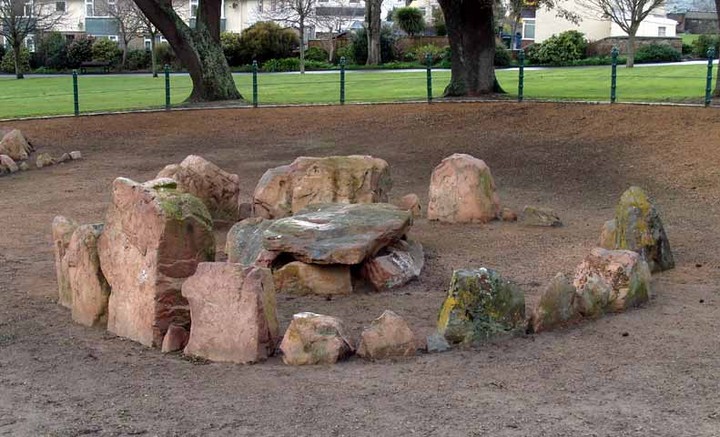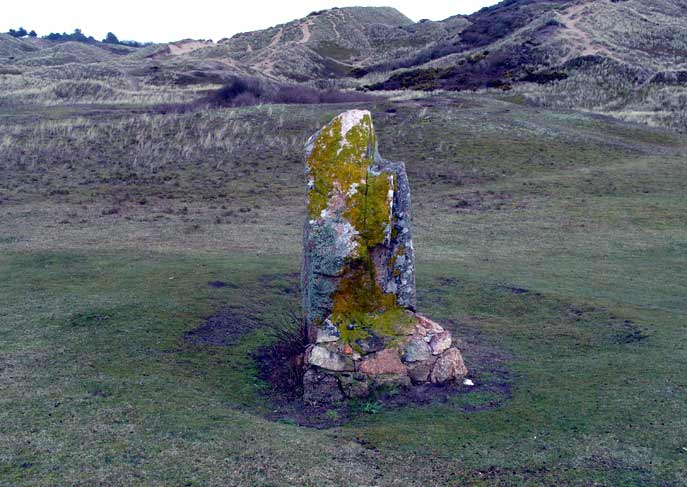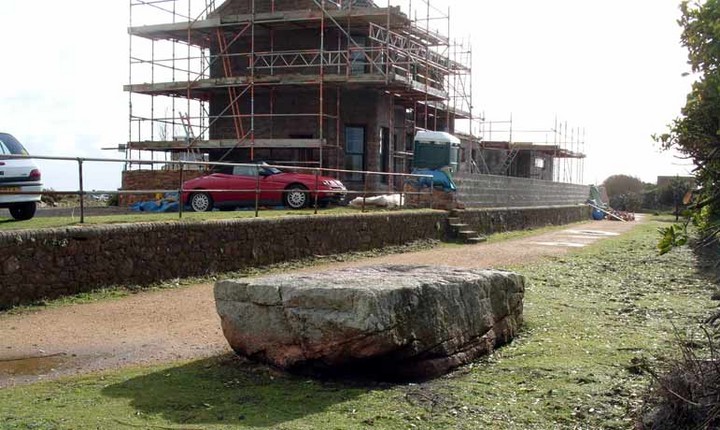
This menhir is just a couple of hundred yards from the airport entrance.
Directions
At the roundabout outside the airport go south (turn right) towards St Brelade along the B36. Turn 1st left (sign for Mermaid Tavern) then immediately left again. The stone is in the field on the right just after the hire car compound.

The noticeboard in the car parks serving this area of sand dunes
The island of Jersey is well endowed with megalithic sites. Here, you’re never far from something of interest. However, if you want to see all of the major sites you’ll need some form of transport.
I flew in to St Helier airport and collected a hire car from there. The hire car company gave me a map; it was crap. Be sure to get the free map from the airport with “Jersey recommended” on the front. You may need good eyesight or a magnifying glass to see it, but it has got all of the main sites marked and named on it.
I drove directly to La Hougue Bie. There’s a small museum there, so, even though I had done some research, I thought they may have a guide to the other sites on the island. There were two useful and complementary free leaflets. “Where to find the dolmens of Jersey” and “The spiritual landscape”. On Jersey, they call all of their prehistoric burial chambers “dolmens”.
Entrance to La Hougue Bie (the only megalithic site at which you have to pay) is £6.50 in 2008.
Most of the roads are narrow and parking is difficult everywhere unless you can find a car park. Luckily, there was always a nearby car park or a handy, flat field boundary whenever I needed to stop.

The site from the north with the cist-in-circle in the foreground and the allee couverte behind

The site from the south east

The site from the south west

The allee couverte from the north west

The allee couverte from the west

The allee couverte from the north east

The cist-in-circle from the north east

The cist-in-circle from the north west

The cist within the cist-in-circle

The noticeboard at the site

The noticeboard at the site
From Lynn News:
“VISITORS will be taken back in time 4,000 years when (King’s) Lynn Museum re-opens to the public on Tuesday (1st April) after its £1.2 million redevelopment.
For on display for the first time will be Seahenge – the man-made timber circle found on Holme beach in 1998 which has been hailed one of Britain’s most exciting archaeological discoveries.
A new gallery has been created to show half the 55 preserved timbers from the circle and the giant upturned oak stump they surrounded, against an illuminated backdrop of Holme beach today.”
Update
Old timbers bring in new visitors
A Norfolk museum has recorded a large increase in visitors since opening a unique display of the Bronze Age wood circle known as Seahenge.
The Lynn Museum in King’s Lynn underwent a £1.2m redevelopment before the exhibition was opened last month.
Norfolk Museums Service said 1,500 visited in its opening month, 73% more year-on-year before the display opened.

The stone was in an arable field so I couldn’t get very close

The first view of the site as one approaches from the north

The passageway leading to the chambers

The chamber area

Looking down the passage from the chamber area

The noticeboard at the site
The official webpages for La Hougue Bie giving directions and opening times.

A partitioned area within the chamber

The noticeboard at the site

The noticeboard at the site

The entrance

The passage to the chamber

The end chamber

The noticeboard at the site



















